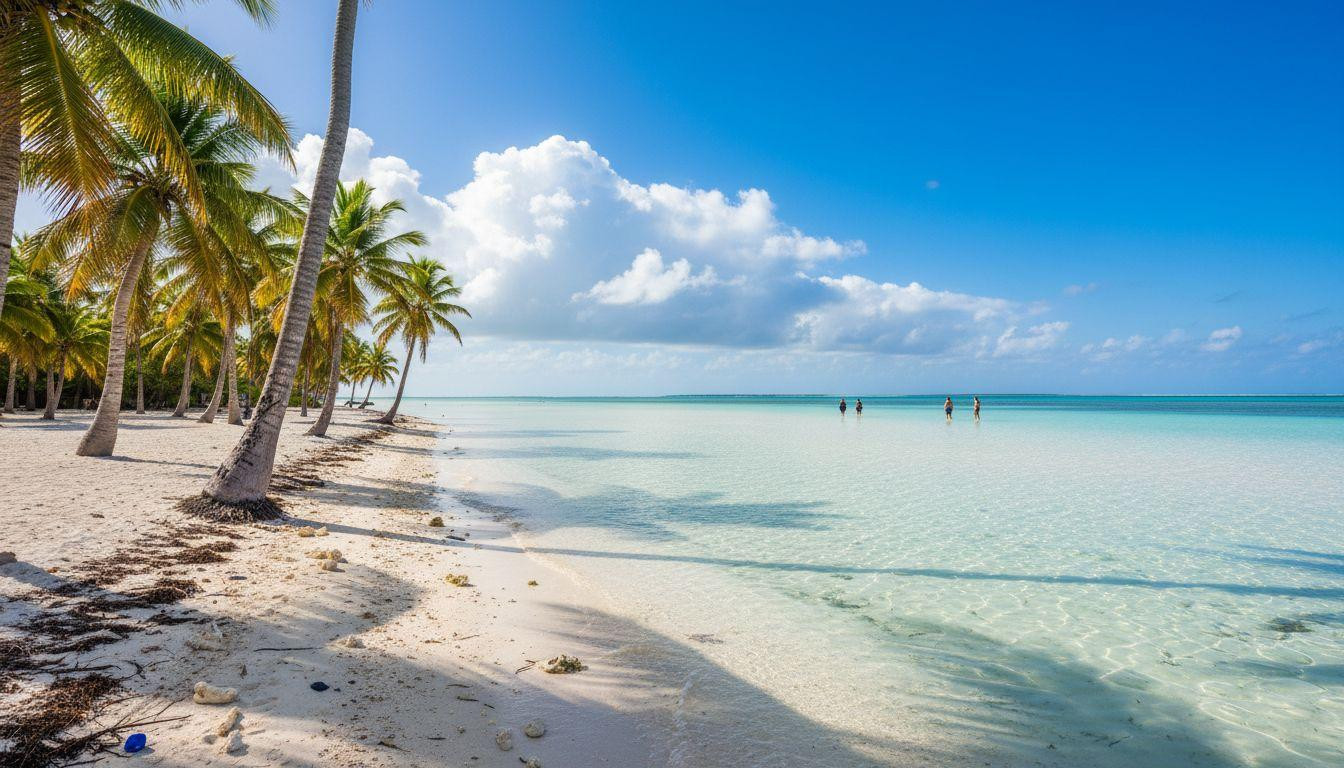The water stays waist-deep as you walk 300 yards offshore into Coco Plum Beach’s crystal expanse. This Great Exuma phenomenon defies Caribbean beach logic. Most shores drop into deep blue within steps of the sand.
Here, powder-white sandbars stretch like underwater highways into pale aqua water. The bottom remains visible hundreds of yards from shore. Your feet never lose contact with silky sand.
The sandbar phenomenon
Coco Plum’s sandbars extend at least 300 yards into the sea according to visitor reports. The underwater platforms maintain ankle to shin depth at low tide. Some visitors document walking nearly a mile offshore before needing to swim.
Geological forces created these shallow shelves over centuries. Tidal action deposits fine sand in consistent patterns. The result: natural walkways that seem to stretch toward the horizon.
When the sandbars reveal themselves
Low tide transforms Coco Plum into an aquatic playground. Plan arrival 2 hours before low tide for optimal exploration. November’s moderate tides offer 4-hour windows of shallow water walking.
Morning light illuminates the sandbars’ pale sand through clear water. Afternoon visits provide dramatic photography opportunities in shallow Caribbean bays as shadows lengthen across the underwater landscape.
Walking into the ocean
The first steps feel ordinary. Beach sand gives way to submerged sand. Water reaches your ankles, then calves, stabilizing at waist level for hundreds of yards.
Crystal clarity reveals every shell and ripple beneath your feet. The 80°F water temperature in November matches the air. No thermal shock interrupts this surreal beach walk.
Sand dollars and starfish
Live sand dollars cluster on the sandbars in extraordinary numbers. Recent visitors report finding over 100 specimens during single low tide explorations. Starfish dot the shallow areas alongside the distinctive circular shells.
The abundant marine life thrives in these protected shallows. Stingrays glide through deeper channels between sandbar sections. Gentle nurse sharks occasionally patrol the area.
Photography on the sandbars
The visual drama unfolds in layers. Powder-white sand contrasts with pale turquoise water. The horizon blurs the boundary between sea and sky. Visitors appear to walk on water from shore perspectives.
Early morning and late afternoon provide golden hour lighting. The sun’s angle illuminates the shallow depths while creating dramatic shadows. Underwater shots capture the sandbar’s texture through crystal-clear water.
Life at Coco Plum
No restaurants or facilities exist at this remote beach. The single weathered building serves as a landmark for arriving visitors. Bring water, snacks, and reef-safe sunscreen for day-long explorations.
The 40-minute drive north from George Town requires careful navigation. Queen’s Highway provides paved access until the final dirt road stretch. Recent rains create muddy conditions requiring 4-wheel drive vehicles.
Getting there
Turn right off Queen’s Highway when you spot the blue wall landmark. Follow the unpaved road 1 mile to the beach parking area. Local residents provide directions using colored trash bins as waypoints.
The faded Coco Plum Beach sign proves difficult to spot. GPS coordinates help navigate the unmarked final approach. Undeveloped Caribbean beaches often require similar adventurous access routes.
What makes it special
Coco Plum maintains its authentic character through minimal development. Palm trees provide scattered shade along the 2-mile shoreline. The absence of commercial infrastructure preserves the natural atmosphere.
Steventon and Rolleville, the nearest settlements, consist of traditional Bahamian homes painted in pastel colors. The area’s 7,000 residents prioritize fishing and farming over tourism development. Free parking reflects the uncommercial approach.
Beyond the sandbars
Snorkeling opportunities extend beyond the shallow sandbars into slightly deeper water. Visibility remains excellent at 15-20 feet from shore. The calm conditions suit families with children seeking gentle ocean exploration.
November weather delivers 82°F daytime temperatures with 7 hours of daily sunshine. The shoulder season provides ideal conditions without summer crowds. Coastal destinations with unique natural features offer similar off-season advantages for patient travelers.
Your questions about Coco Plum Beach answered
When should I visit for the best sandbar experience?
Plan visits around low tide for optimal sandbar walking. November through April provides the most comfortable weather conditions. Check tide charts before departure as timing affects water depth significantly. Early morning arrivals often guarantee solitude on the sandbars.
What should I bring to this remote beach?
Pack all supplies including water, snacks, and snorkeling gear. No facilities exist on site. Reef-safe sunscreen protects both skin and marine environment. A waterproof camera captures the unique sandbar perspectives. Sturdy water shoes help navigate occasional coral patches.
How does Coco Plum compare to other Exuma beaches?
Coco Plum’s extensive sandbars distinguish it from southern Exuma’s deeper water beaches. Stocking Island and Sandals resort areas offer different experiences with more facilities but less natural character. The northern location provides authentic Bahamian atmosphere without commercial development.
Late afternoon light streams across the returning tide. The sandbars slowly disappear beneath deeper water. Your footprints wash away in the gentle current. Tomorrow’s low tide will reveal this underwater world again.
